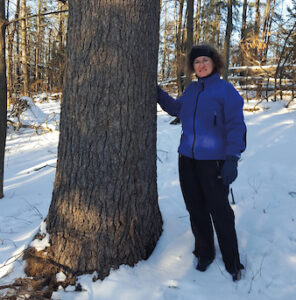Carrie Pike ’93
 Degrees: B.S. in biology; M.S. in forestry, SUNY College of Environmental Science and Forestry; Ph.D. in natural resources, University of Minnesota
Degrees: B.S. in biology; M.S. in forestry, SUNY College of Environmental Science and Forestry; Ph.D. in natural resources, University of Minnesota
Job Title: Regeneration specialist with the USDA Forest Service—State, Private, and Tribal Forestry with the Eastern Region; based in West Lafayette, Indiana
Favorite Trinity Memory: I ran cross country and track all 3½ years (except when I studied abroad), and I appreciated the friendships and camaraderie of the teams! Track and cross country parties were fun and memorable. I’m also still in touch with many of my North Campus dormmates from freshman year who are fantastic people.
What was your path to your current position? I took a very nonlinear path. I enjoyed my biology classes at Trinity, but my study abroad at the Center for Rainforest Studies of the School for Field Studies introduced me to forestry and ecology. I wanted to do that. But I didn’t know how to start, so I traveled abroad, after graduating, to Australia and Central America. Upon returning, I started doing temp work in New York City while living with my parents on Long Island (this was a low point). One of my many rejected résumés was eventually picked up, and I was offered a summer job as a field assistant on a project on Long Island, looking at black oak trees, that later became the subject of my master’s degree.
What do you do as a regeneration specialist? I provide technical assistance to partners (federal, state, tribal, NGO, etc.) on topics related to forest genetics. My expertise is in tree improvement and tree breeding, but I also provide guidance on assisted migration, tree seed, tree nurseries, and seed zones. In addition, I manage and monitor grants for state and tribal nurseries in the 20-state region that I cover. Those grants are part of the Biden/Harris Bipartisan Infrastructure Law (BIL).
Why do you feel your work is important? Applied forest genetics is an important skill set for foresters and land managers working in forest regeneration, but few understand or appreciate forest genetics (most are intimidated by it). I do my best to make forest genetics understandable and useful so I can help land managers make good decisions about seed sources to use for planting.
What do you enjoy most about your work? I love that I can help our partners do better work related to reforestation. I also love seeing tangible progress with tree species, including butternut (white walnut) and American elm, that are struggling with nonnative pests. Genomics is a useful tool, but in tree breeding we rely on common garden studies to sort out genetic and environmental effects. There is simply no substitute for a well-executed common garden to answer most of our pressing questions about tree health, growth, and within-species variation.
What challenges do you face? My job was once held by two people: one who specialized in nurseries and another who specialized in genetics. My predecessor had both jobs, and I inherited both as well. With the recent ramp-up in reforestation across the United States, demand for technical assistance with nurseries is a growing need. Luckily, I am part of a national team that includes nursery specialists, and we help one another.
How did your time at Trinity prepare you for your career? Trinity provided me with a solid foundation of biology and helped hone my writing and analytical skills. I was pleasantly surprised to find that many of the faculty at my graduate institutions had earned B.S. or B.A. degrees from small liberal arts colleges like I had.
What were the most memorable courses you took at Trinity? I was inspired by Craig Schneider’s botany class, but I also enjoyed studying Dante’s Divine Comedy with Dario Del Puppo. Cheryl Greenberg was the first professor to make history fun and entertaining!
Did you have a Trinity professor who was particularly influential? Craig Schneider and Kathy Archer were most influential in terms of my career path. I knew I wanted to study plants (or trees), and both are experts. I was one of very few students in my biology class with zero aspirations to study medicine, so it was nice to have professors who work with plants. Both were passionate about their work and were great instructors. I had no previous exposure to plant science, and I was grateful to learn that the word “botanist” referred to a potential career path! This was a novelty to me, a kid from Long Island, who liked nature and enjoyed playing under the hemlocks on our postage-stamp-sized urban property but had no idea about career opportunities in the plant sciences.
